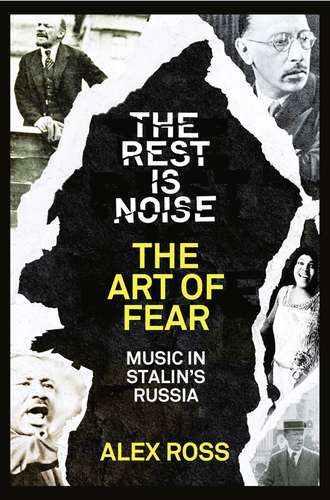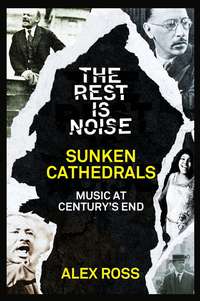
Полная версия
The Rest Is Noise Series: The Art of Fear: Music in Stalin’s Russia
In November 1931, Shostakovich made what seemed a brave move. Fed up with the agitations of the proletarians, he issued a manifesto, “Declaration of a Composer’s Duties,” stating that demands for songfulness in Soviet music and theater were having a ruinous effect on composers. In fact, as Shostakovich may well have been aware, the Party was about to disavow the proletarian line; the following April, RAPM was dissolved, and the new Union of Soviet Composers took its place. You can sense a certain cackling quality in the music that Shostakovich wrote for Nikolai Akimov’s irreverent 1932 production of Hamlet, which opened in Moscow a month after the demise of RAPM. In Act III, Scene 2, Hamlet accuses Rosencrantz and Guildenstern of trying to play him like a pipe, and in the Akimov production the prince dramatized his contempt by lowering a flute to his buttocks. At that moment, Shostakovich had a piccolo in the orchestra pipe out Alexander Davidenko’s mass song “They Wanted to Beat Us, to Beat Us,” a favorite of the proletarian faction.
After years of collectivization, industrialization, and famine, the Soviet populace was feeling rebellious, and in the early thirties Stalin tried to placate his subjects by promising new comforts and freedoms. Artists were deputized to broadcast the message that “life is getting better,” as Stalin eloquently put it. To this end, artists’ lives were made better, at least in the material sense. The Union of Soviet Composers supplied composers with health plans, sanatoriums, and a cooperative building in Moscow. At an October 1932 gathering at Maxim Gorky’s Moscow mansion, Stalin mused aloud that writers should be “engineers of human souls,” and the writers debated among themselves what he meant. From the meeting emerged the concept of socialist realism, according to which Soviet artists would depict the people’s lives both realistically and heroically, as if from the standpoint of the socialist utopia to come. Established nineteenth-century forms such as the novel, the epic drama, the opera, and the symphony were deemed suitable vehicles of expression, although they required thorough renovation in line with Soviet thought. The Party theorist Nikolai Bukharin, at the Writers’ Congress of 1934, offered a more elaborate definition of socialist realism, calling for stories of “tragedies and conflicts, vacillations, defeats, the struggle of conflicting tendencies.”
Shostakovich’s first contribution to the new phase in Soviet art was Lady Macbeth of the Mtsensk District. The libretto, based loosely on a story by Nikolai Leskov, tells of Katerina Ismailova, a strong-willed woman in a provincial town in 1860s Russia. Variously bored and oppressed by the men in her life, she finds it convenient to dispose of them. She first kills her father-in-law, Boris, whom Shostakovich identified as a “typical master kulak,” or wealthy landowning peasant, in order to save herself from his repulsive advances. She then connives with her lover, Sergei—a “future kulak”—to kill her jealous, abusive husband, Zinovi. The last act takes place in a Siberian prison camp, to which the lovers have been consigned. When Sergei’s eyes wander to another woman, Katerina drowns herself in a river, taking her rival with her.
What made this scenario politically timely was that in 1929 Stalin had launched a genocidal campaign of “liquidating the kulaks as a class,” whether by execution, imprisonment, or deportation. Shostakovich himself gestured toward the subtext: “In Lady Macbeth I wanted to unmask reality and to arouse a feeling of hatred for the tyrannical and humiliating atmosphere in a Russian merchant’s house-hold.” These “petty,” “vulgar,” “cruel,” “greedy” merchants are Soviet counterparts to the hook-nosed banker Jews who appeared in Nazi cartoons of the same period. Robert Conquest estimates that three million people died as a result of the “dekulakization” program.
Seen from one angle, then, Lady Macbeth is nearly an opera in the service of genocide. In other ways, however, it is anything but a propaganda work. The composer called it a “Tragedy-Satire,” and that ambiguity sets the tone; nothing can be taken entirely at face value. Extending Eisenstein’s notion of discord between sound and image, Shostakovich uses cartoonish musical stereo types to undermine rather than illustrate the action onstage. The attempted rape of Katerina’s cook, Aksinya, for example, plays out against a manic galop worthy of Walt Disney’s Silly Symphonies. Boris’s lust for Katerina is represented by a drunken Viennese waltz. As the opera goes on, hard-hearted grotesquerie gives way to spells of confession and lamentation. When Boris is killed in Act II, the musical reaction is at first icily unsympathetic, but after a priest offers to say a requiem for the merchant, the orchestra takes the stage with a grandiose dirge in the form of a passacaglia, rather plainly modeled on the D-minor threnody in Berg’s Wozzeck. The dramatic function of this music is obscure. Is it, unexpectedly, a statement of sympathy for the awful Boris? Does it express internal turmoil on the part of Katerina? The general grinding operation of fate? What ever it means, it fails to advance the stated program of stirring hatred for the kulaks.
The opera makes more sense as a fable of the madness of love, of the disorienting power of sexuality. It was written under the spell of the physicist Nina Varzar, whom Shostakovich married in 1932; the soprano Galina Vishnevskaya thought that Katerina was an exaggerated depiction of Nina’s passionate nature. But the madness may really have been Shostakovich’s own; two years later, he would fall in love with the young translator Elena Konstantinovskaya, precipitating a crisis in his marriage, and his romantic life would display tragicomic aspects ever after. The writer Galina Serebryakova recalled: “[Shostakovich] was thirsting to re create the theme of love in a new way, a love that knew no boundaries, that was willing to perpetrate crimes inspired by the devil himself, as in Goethe’s Faust.” Katerina is too consumed by her desires to register the absolute corruption around her; instead, like Salome, she exposes the insanity of her world by embodying it to excess. In this sense, the opera becomes an altogether darker kind of monument to Stalin’s world.
Terror
Shostakovich was not the first Soviet composer to be censured by the state. In 1935, Gavriil Popov, a greatly gifted artist who had studied alongside Shostakovich at the Leningrad Conservatory, unveiled his First Symphony, an immensely forceful hour-long work to which Shostakovich’s subsequent symphonies owe a more than minor debt. After the premiere, a censorship board denounced Popov’s symphony as a work of “class-enemy character” and banned further performances. With Shosta kovich’s support, Popov succeeded in having the ruling overturned. But the renewed assault on musical and artistic formalism in 1936 meant that the piece was taken out of circulation again. Popov began a long descent into alcoholism and mediocrity. The difference between his fate and Shostakovich’s says much about the latter’s power of endurance, his ability to preserve his musical self under potentially annihilating pressure.
Конец ознакомительного фрагмента.
Текст предоставлен ООО «ЛитРес».
Прочитайте эту книгу целиком, купив полную легальную версию на ЛитРес.
Безопасно оплатить книгу можно банковской картой Visa, MasterCard, Maestro, со счета мобильного телефона, с платежного терминала, в салоне МТС или Связной, через PayPal, WebMoney, Яндекс.Деньги, QIWI Кошелек, бонусными картами или другим удобным Вам способом.








